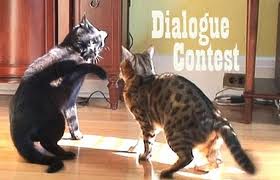Entire books have been written on the subject of dialogue. Of all the definitions, I like this one best: “Dialogue sounds like real speech–but isn’t.” Yet many novel writers struggle.
Writing Tip for Today: What can you do to improve your dialogue? Here are three easy ways:
- Mix it Up with Beats. Practice weaving action, inner thought, body language and setting reminders. If you leave all these elements in separate chunks, your reader won’t have a cinematic experience. In and around the spoken lines, relate those other elements with one sentence “beats.” Many times you can replace dialogue attributions (he said) with a beat. By letting readers know more than just the dialogue, they will be able to imagine the whole scene much more readily.
- Say it Like You Mean It. Dialogue in a story MUST be about the story. This means steering away from chit-chat (How are you, I am fine), extraneous conversation stoppers such as well, um, er, and information loading (stuff put into the character’s mouth for the author’s convenience). Instead remember to keep more than one person in a scene (What I call the Wilson Principle)*, and try having characters give more than yes or no answers. If one character asks a question, put an unexpected rejoinder with it. (EX: Are you going to the concert? Who wants to know?)
- Use the Rule of Three. You may have heard that writers should avoid “talking heads,” or dialogue with little or no narrative around it. The Rule of Three states that whenever a character speaks three lines of dialogue, consider changing over to a beat of action, inner thought or body language (emotion), or let another character speak. If you’ve written three exchanges or paragraphs of dialogue, consider a few lines of narration to change things up. Good luck with your dialogue!
*Wilson Principle: In the film, “Castaway,” Tom Hanks is stranded on a deserted island. If he hadn’t had Wilson the soccer ball to talk to, the film would have suffered from long monologues. Wilson made Hanks’ character more interesting and helped move the story.







Thanks! This is exactly the kind of concrete how-to advice I need! I’m going through my wip right away with beats and rule of three in mind.
Carolyn,
So glad to be of help. You can use Rule of 3 for flashbacks too–more than 3 sentences, touch base with the real time scene. I call this the Cold Mashed Potatoes rule and you can find posts on that in my archives. Thanks for reading! Write On! ~Linda
Thank You, Linda! 😀
You’re welcome, Dolores! Keep writing! ~Linda